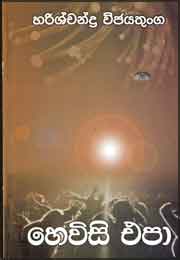Focus on books
Multi faceted creative streams
Prof. Sunanda Mahendra
He Visi Epa
A collection of 45 Sinhala Poems
by Dr Harsichandra Vijayatunga
An author publication, 2007
Price Rs. 200 (104 pages)
Dr. Vijayatunga, the science writer, teacher, lawyer, translator,
text book compiler and lexicographer is mostly known for his politics.
His first collection of poems titled 'Pahanvida' appeared as far back as
mid sixties, and was discussed widely by the critics and well wishers.
Now as his second collection of poems 'Hevisi Epa' has appeared after a
long spell of time, it would be pertinent to examine some of the poetic
creativities of mature personality.
Harischandra Vijayatunga (HV) selects most of his poetic expressions
from religion, history, folklore, politics, and other day to
observations in order to sensitively drive in a particular message.
At the outset I tried to read the title poem 'He visi Epa', where the
persona, though dead physically appears around the coffin or dead body
in order to bring out a message relating to living and dying.

Here the persona seem to express that as the death is inevitable, but
in a metaphysical layer of expression, and death is also a moment to
recollect events of a person's life span. As such death is a birth in an
indirect manner.
HV makes use of a discourse like dialogues that ensue between people
to express some socio political cross currents.
Baiyek Rayavi (26) is one example which is based on the Mahawamsa
legend of a king who allowed one of his courtiers, who looked like
himself to rule for a day. This legend of the comedy of errors in the
hands of HV is twisted to suit some of the contemporary political trends
over the years.
A similar poem is Mee Kedu Ata (25) of a man who enters a petrol
station to inflate his punctured tyre. But the attendant in charge is so
kind that he says that the place is nationalised, and it is difficult to
do as the inflating instrument is out of order.
What happens is that the victim of the circumstances comes to know
about his own plight and accepts that after all most things around him
are 'out of order'. There is a certain degree of a satirical outlook and
a vision embedded in these poems. I found most of his poems expressive
of a satirical creation, which is rare nowadays.

HV though possessive of a political ideology of his own relating to
the national conscience does not attempt to forcefully punch it on the
reader. Instead he tries to present it rather ironically evoking a
chagrin on the reader's face.
This creation of a sense of inner awakening, I presume, should be
regarded more seriously than mere reading of the outer layer.
Though erudite in the classical poetic tradition, HV uses a sort of a
blank verse pattern with a dramatic emphasis. Some examples are Togen
mitiyai magen mitiyai (28), Heva lihi Bandima (32).
This poem reminds me of the graceful creation of the poet Munidasa
Cumaratunga. But in this particular case, HV turns the skills of 'Hava'
tipsy turvy, taking the image of the hare as drawn in the moon by the
Sakra or the god of gods as being removed by the so called modern human
beings.
What is emphasised is that the image of the age old legendary hare in
the moon is being taken out in order to twist the age old religious
ideology for one's own benefit.
A similar poetic creation is Guvene a tati bana (34) where the poet
depicts a narrowing down of the age old sermons when they are made to be
recorded on discs and tapes mechanically with the sole intention of
commercial gains.
However he does not state it openly, instead suggests that with the
dawn of the mechanistic and media oriented and media oriental culture
even the spirit of the age old sermons get polluted.
He typifies them as Tatibana or disked sermons meant to be sold as
commercial commodities. It is observed that some of the creations are
based on Chinese and English poems. But the reader may not feel a sense
of alienation in the conveyance of the central poetic experience.
The two poems Marka hevana (15) and Navaluapitiya Andonawa (20) are
two sensitive creations where the pivotal influence is drawn from
folklore.
In 15, the poet visually presents forest with its age old trees
unharmed by big animals like elephants. One fine day one of the oldest
and hardest trees is seen felled down as a result of the ant bites over
the years that is signified as the gradual decay of the order brought
about by a galaxy of insignificant creatures.
In 20, a particular mother addresses and Ulama bird, which is said to
bring disaster with his evil calls, to stop his lamenting cry, as her
son is going to enter into a new world, where he will be crowned as a
highly skilled person.
What is ironically hinted is that the new world to which he will
enter may be the place where he will be jack of all trades and a master
of none.
A high degree of classical grace is seen in the diction. This is one
of the most striking factors of the most these poetic creations.
All in all, these poems as I enjoy them, are a welcome cluster of a
variance from the existing pattern of the Sinhala poems we come across
today.
Though at least three decades have gone since the appearance of his
first collection of poems, one ought to observe a certain sense of
freshness and maturity in these poems.
[email protected]
|

